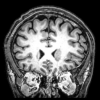OK, so most of us should know that nicotine is a nicotinic acetylcholine receptor agonist ; that is, it selectively activates a multitude of acetylcholine receptors in the nicotinic class(hence the name "nicotine").
Well I did more digging in my spare time this week, it appears that a good method of treating anxiety and depression may lie in this excerpt/study.
Before we can understand this, you have to learn these two terms , at least.
What does TH mean in neurobiology or reference to neurotransmission? = TYROSINE HYDROXYLASE ; the enzyme by which tyrosine gets converted into L-DOPA; which subsequently can convert into dopamine.
In simpler terms, "TH" is an enzyme needed to make dopamine, and is directly proportional to how much protein or amino acids get converted into dopamine.
The more TH, the more dopamine by however much L-Tyrosine you take in.
This includes food sources.
SECOND TERM, what is GADfolks? = Glutamate decarboxylase; this enzyme is RESPONSIBLE for converting glutamate into the inhibitory neurotransmitter; GABA.
This means that GAD (glutamate decarboxylase) is an important factor in determining susceptibility to glutamate induced neurotoxicity and cell death as well as anxiety disorders that may be amplified or caused by glutamate issues.
Now until this point, many of you may have only seen sex hormones, adrenal hormones and such as regulators of these enzymes, for example, thyroid hormones facilitate TH activity, and so does testosterone.
But what controls GAD activity? Well one hormone is prolactin, but of course, we are not looking to raise prolactin here, that would be dangerous in other ways.
Now let's get back to the nicotinic concept, just read below.
Co-localization of α4 with TH and GAD67
Mice (n=2/genotype) were anesthetized with Nembutal (50 mg/kg) intraperitoneal injection (i.p.) and subjected to cardiac perfusion with 20mLs RNAse free phosphate buffered saline solution (PBS; 100mM NaCl, 10mM sodium phosphate buffer, pH 7.5) followed by 50mLs 4% paraformaldyde (PFA). Brains were dissected, cut into 2 mm sections and incubated in 4% PFA for 2 hours at room temperature then in 30% sucrose at 4°C for 20 hours. Each section was then imbedded in Tissue Freezing Medium (Triangle Biomedical Sciences, Durhamn, NC) and rapidly frozen using isopentane on dry ice prior to storage at −80°C. The 2 mm section containing the midbrain was sliced at 15 μm and mounted on to Superfrost Plus slides (VWR, Denver, CO). Sections were hybridized with 600bp digoxigenin-labeled riboprobe complementary to α4 mRNA and a 900bp fluorescein-labeled riboprobe complementary to the 3′ end of glutamate decarboxylase 67 (GAD67) mRNA at 67°C for 16 hours in a buffer containing 50% deionized formamide (Ambion, Austin, TX), 0.1mg/mL tRNA (Ambion, Austin, TX), 10% dextran (Chemicon, Temecula, CA), and 1X Denhardt’s solution (Sigma, St. Louis). The slides underwent 1 hour of stringency washes at 63°C in a saline-sodium citrate buffer containing 50% formamide. Slides were then blocked for 1 hour in a MABT (100mM maleic acid, 150mM NaCl, 0.1% Tween-20 [Roche Diagnostics, Indianapolis, IN], pH 7.5) containing 2% Blocking Reagent (Roche diagnostics, Indianapolis, IN) and 10% sheep serum (Jackson ImmunoResearch, West Grove, PA) and then incubated overnight at 4°C with 1:500 anti-digoxigenin-peroxidase antibody (Roche, Indianapolis, IN). Following 50 minutes of washes in MABT, peroxidase was developed using the Tyramine Signal Amplification (TSA) cyanine3 kit (PerkinElmer Life Sciences, Boston, MA). The reaction was stopped by three 10 minute washes in PBS then any remaining peroxidase was quenched using 3% H2O2 in PBS for 30 minutes at room temperature. This protocol was then repeated to stain the fluorescein-labeled probe with overnight antibody incubation using 1:500 anti-fluorescein-peroxidase antibody (Roche, Indianapolis, IN) and development using the TSA-Cyanine2 kit. Following development of the GAD67 probe, sections were blocked for 2h and then incubated overnight with rabbit anti-tyrosine hydroxylase (ab112; AbCam, Cambridge, MA) in a PBS based blocking solution containing 0.5% donkey serum, 0.25% Triton X-100 and 0.05% cold water fish skin gelatin. The following day after 1 hour of washes in 10% blocking solution, the sections were incubated for 4 hours at room temperature with 1:250 Alexaflour488 goat anti-rabbit (Invitrogen, Carlsbad, CA). Slides were then rinsed for 20 minutes with PBS, dehydrated, cleared with Xylene and cover-slipped. Slides were examined using a Leica TCS SP2 AOBS laser scanning confocal microscope with a 63x oil immersion lens (Mannheim, Germany). The Alexa488 was excited using the 488 nm line of an argon laser, Cy5 using the 633 nm line of a HeNe laser, and Cy3 was excited by a 561 nm DPSS laser. The images presented are a projection of 10 sections collected ~0.5 um apart using Leica Confocal Software (Germany).
In this study, mice of a specific genotype were subjected to cardiac perfusion, then had their brains disected and placed on a slide; then laser scanning tools and neural probes were used to pharmacologically identify the co-localization of alpha-4-nicotinic receptors with both tyrosine hydroxylase and GAD.
Now of course, that would essentially mean, assuming the nerve terminals are functional and interactive, that activating these specific nicotinic receptors would indeed, both increase glutamate conversion into GABA; resulting in anti-anxiety effects - and it would increase dopamine production from tyrosine.
We'd also have to assume that these mice have enough similarity to a human brain, well we can't do that, can we?
EXCEPT that there always are similarities, but it's where the next "coincidence" comes in to play that counts.
Now I saved the "head" excerpt of this study for last, because I wanted to demonstrate that mouse studies can be very useful, when correlated with both human and independent pharmacological justification.
Nicotine is the primary psychoactive substance in tobacco and it exerts its effects by interaction with various subtypes of nicotinic acetylcholine receptors (nAChRs) in the brain. One of the major subtypes expressed in brain, the alpha4beta2-nAChR, endogenously modulates neuronal excitability and thereby, modifies certain normal, as well as nicotine-induced, behaviors. Although alpha4-containing nAChRs are widely expressed across the brain, a major focus has been on their roles within midbrain dopaminergic regions involved in drug addition, mental illness and movement control in humans. We developed a unique model system to examine the role of alpha4-nAChRs within dopaminergic neurons by a targeted genetic deletion of the alpha4 subunit from dopaminergic neurons in mice. The loss alpha4 mRNA and alpha4beta2-nAChRs from dopaminergic neurons was confirmed, as well as selective loss of alpha4beta2-nAChR function from dopaminergic but not GABAergic neurons. Two behaviors central to nicotine dependence, reward and anxiety relief, were examined. Alpha4-nAChRs specifically on dopaminergic neurons were demonstrated to be necessary for nicotine reward as measured by nicotine place preference, but not for another drug of addiction, cocaine. Alpha4-nAChRs are necessary for the anxiolytic effects of nicotine in the elevated plus maze and elimination of alpha4-beta2-nAChRs specifically from dopaminergic neurons decreased sensitivity to the anxiolytic effects of nicotine. Deletion of alpha4-nAChRs specifically from dopaminergic neurons also increased sensitivity to nicotine-induced locomotor depression, however nicotine-induced hypothermia was unaffected. This is the first work to develop a dopaminergic specific deletion of a nAChR subunit and examine resulting changes in nicotine behaviors.
Well there's your pharmacological justification, they were proven to play a role in the anxiolytic (anti-anxiety) effects nicotine AND the pro-dopamine effects of nicotine, so we are looking at INCREASES in GABA and DOPAMINE - all by activating the alpha-4-nicotinic receptor.
Now we're getting somewhere, but we're not done yet.
Mol Pharmacol. 2003 Dec;64(6):1283-94.
Characterization of human alpha 4 beta 2-nicotinic acetylcholine receptors stably and heterologously expressed in native nicotinic receptor-null SH-EP1 human epithelial cells.Eaton JB1, Peng JH, Schroeder KM, George AA, Fryer JD, Krishnan C, Buhlman L, Kuo YP, Steinlein O, Lukas RJ.Erratum in
- Mol Pharmacol. 2004 Jul;66(1):197.
AbstractNaturally expressed nicotinic acetylcholine receptors composed of alpha4 and beta2 subunits (alpha4beta2-nAChR) are the predominant form of high affinity nicotine binding site in the brain implicated in nicotine reward, mediation of nicotinic cholinergic transmission, modulation of signaling through other chemical messages, and a number of neuropsychiatric disorders. To develop a model system for studies of human alpha4beta2-nAChR allowing protein chemical, functional, pharmacological, and regulation of expression studies, human alpha4 and beta2 subunits were stably introduced into the native nAChR-null human epithelial cell line SHEP1. Heterologously expressed alpha4beta2-nAChR engage in high-affinity, specific binding of 3H-labeled epibatidine (H-EBDN; macroscopic KD = 10 pM; kon = 0.74/min/nM, koff = 0.013/min). Immunofluorescence studies show alpha4 and beta2 subunit protein expression in virtually every transfected cell, and microautoradiographic studies show expression of 125I-labeled iodo-deschloroepibatidine binding sites in most cells. H-EBDN binding competition studies reveal high affinity for nicotinic agonists and lower affinity for nicotinic antagonists. Heterologously expressed alpha4beta2-nAChR functional studies using 86Rb+ efflux assays indicate full efficacy of epibatidine, nicotine, and acetylcholine; partial efficacy for 1,1-dimethyl-4-phenyl-piperazinium, cytisine, and suberyldicholine; competitive antagonism by dihydro-beta-erythroidine, decamethonium, and methyllycaconitine; noncompetitive antagonism by mecamylamine and eserine; and mixed antagonism by pancuronium, hexamethonium, and d-tubocurarine. These results demonstrate utility of transfected SH-EP1 cells as models for studies of human alpha4beta2-nAChR, and they also reveal complex relationships between apparent affinities of drugs for radioligand binding and functional sites on human alpha4beta2-nAChR.
AND FINALLY TO PUT THE ICING ON THE CAKE
Neurosci Lett. 2008 Jan 3;430(1):34-7. Epub 2007 Oct 22.
Smoking upregulates alpha4beta2* nicotinic acetylcholine receptors in the human brain.Wüllner U1, Gündisch D, Herzog H, Minnerop M, Joe A, Warnecke M, Jessen F, Schütz C, Reinhardt M, Eschner W, Klockgether T, Schmaljohann J.AbstractThe role of the alpha4beta2* nicotinic acetylcholine receptors (nAChR) in tobacco addiction in humans is largely unresolved. We visualized brain alpha4beta2* nicotinic acetylcholine receptors of smokers and non-smokers with positron emission tomography using 2-[(18)F]fluoro-3-(2(S)azetidinylmethoxy)pyridine, commonly known as 2-[(18)F]F-A-85380. The total brain distribution volume of 2-[(18)F]F-A-85380 was significantly increased in smokers. Statistical parametric mapping revealed that the most prominent regional differences of distribution volumes (DV) were found in cerebellum and brainstem with an increased uptake in smokers. The up-regulation of alpha4beta2* nAChR upon chronic nicotine exposure via tobacco smoking incorporates subcortical brain regions which may play an important role in nicotine addiction.
PMID: 17997038 [PubMed - indexed for MEDLINE]
Edited by Area-1255, 22 January 2015 - 05:58 PM.




























































